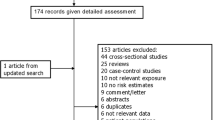Abstract
Albert Einstein's biographers have not explained why he developed the abdominal aortic aneurysm that led to his death. Early conjectures proposed that it was caused by syphilis, without accurate evidence. The present article gives evidence to the contrary, and argues that the principal cause of Einstein’s death was smoking.


Similar content being viewed by others
References
Jürgen Neffe, Einstein: A Biography (Baltimore: Johns Hopkins University Press, 2007), 126.
Clarence Streit, “Einstein Evolving Yet Another Theory,” The New York Times, July 27, 1930.
“Dr. Einstein Consults California Physicists,” The New York Times, January 4, 1931.
Peter Plesch and János Plesch, “Some Reminiscences of Albert Einstein,” Notes and Records of the Royal Society of London 49 (1995), 320.
Jeremy Bernstein, Albert Einstein and the Frontier of Physics (New York: Oxford University Press, 1996); Denis Brian, Einstein: A Life (New York: J. Wiley, 1996); Ronald Clark, Einstein: The Life and Times (New York: World Publishing Company, 1971); Albrecht Fölsing, Albert Einstein: A Biography (New York: Penguin Press, 1997); Walter Isaacson, Einstein: His Life and Universe (New York: Simon and Schuster, 2007); Jürgen Neffe, Einstein: A Biography; Abraham Pais, Subtle IS the Lord (New York: Oxford University Press, 2005).
Jorge Cervantes-Castro, “Albert Einstein and His Abdominal Aortic Aneurysm,” Gaceta Médica de México 174 (2011), 74–76; J. Chandler, “The Einstein Sign: The Clinical Picture of Acute Cholecystitis Caused by Ruptured Abdominal Aortic Aneurysm,” The New England Journal of Medicine 310 (1984), 1538; J. R. Cohen and L. M. Graver, “The Ruptured Abdominal Aortic Aneurysm of Albert Einstein,” Surgery, Gynecology and Obstetrics 170 (1990), 455–58; S. Kantha, “An Appraisal of Albert Einstein’s Chronic Illness,” Medical Hypotheses 42 (1994), 340–46.
Albert Einstein, The Collected Papers of Albert Einstein, vol. 5, trans. Anna Beck (Princeton: Princeton University Press, 1995), 348.
Albert Einstein, The Collected Papers of Albert Einstein, vol. 8, trans. Ann Hentschel (Princeton: Princeton University Press, 1998), 122.
Albert Einstein, The Collected Papers of Albert Einstein, vol. 10, trans. Ann Hentschel (Princeton: Princeton University Press, 2006), 445n4.
Brian, Einstein: A Life (ref. 5), 265.
Quoted in Leonard Lyons, “Einstein Has Pipes, but Won’t Smoke,” The Austin Statesman, September 9, 1947, 4.
János Plesch, János, the Story of a Doctor, trans. Edward Fitzgerald (London: Victor Gollancz, 1947), 213.
Justin Stares, “Einstein, Eccentric Genius, Smoked Butts Picked up off Street,” The Telegraph, accessed October 4, 2015, http://www.telegraph.co.uk/news/worldnews/europe/belgium/1502358/Einstein-eccentric-genius-smoked-butts-picked-up-off-street.html.
Plesch and Plesch, “Reminiscences of Albert Einstein” (ref. 4), 320.
Ibid.
Ibid., 328n15.
Jamie Sayen, Einstein in America (New York: Crown, 1985), 222.
“Achievements in Public Health, 1900-1999: Tobacco Use—United States, 1900–1999,” Centers for Disease Control Morbidity and Mortality Weekly Report, accessed October 4, 2015, http://www.cdc.gov/mmwr/preview/mmwrhtml/mm4843a2.htm.
“Einstein Joins Pipe Club,” The New York Times, March 12, 1950.
K. Craig Kent, “Abdominal Aortic Aneurysms,” The New England Journal of Medicine 371 (2014), 2101–8.
Quoted in Pais, Subtle is the Lord (ref. 5), 477.
Plesch and Plesch, “Reminiscences of Albert Einstein” (ref. 4) 309.
Ibid., 310.
Ibid.
Jeremy Bernstein, “Janos Plesch,” Harvard Magazine, January-February 2004, accessed October 4, 2015, http://harvardmagazine.com/2004/01/janos-plesch.html.
Jeyakumar Williams, Gopi Krishnan, and Hema Devarajan, “Syphilitic Abdominal Aortic Aneurysm,” AIDS Patient Care and STDs 16 (2002), 468.
Nelson Paulo, José Cascarejo, and Luís Vouga, “Syphilitic Aneurysm of the Ascending Aorta,” Interactive Cardiovascular and Thoracic Journal 14 (2012), 4450–71.
M. H. Pappworth, “Abdominal Aneurysm and Syphilis,” The Lancet 237 (1941), 804.
Diana Kormos Buchwald, director of the Einstein Papers Project, informs me that, as far as she is aware, the project does not contain Einstein’s medical records or autopsy report.
Félix Ramírez, “Albert Einstein and Aortic Aneurysm,” Argentine Journal of Cardiology 83 (2014): 250, http://doi.org/10.7775/rac.v82.i3.4089.
K. Craig Kent et al., “Analysis of Risk Factors for Abdominal Aortic Aneurysm in a Cohort of more than 3 Million Individuals,” Journal of Vascular Surgery 52 (2010), 539–48.
Teun Wilmink, Clive Quick, and Nicholas Day, “The Association between Cigarette Smoking and Abdominal Aortic Aneurysms,” Journal of Vascular Surgery 30 (1999), 1099–105.
Kent, “Abdominal Aortic Aneurysms” (ref. 20).
B. Timothy Baxter, “Medical Management of Small Aortic Abdominal Aortic Aneurysms,” in Aortic Aneurysms: Pathogenesis and Treatment, ed. Gilbert R. Upchurch, Jr., and Enrique Criado (New York: Humana Press, 2009), 62.
J. T. Powell, P. Worrell, S. T. MacSweeney, P. J. Franks, and R. M. Greenhaigh, “Smoking as a Risk Factor for Abdominal Aortic Aneurysm,” Annals of the New York Academy of Sciences 800 (1996), 246–8, on 247.
“Final Recommendation Statement Abdominal Aortic Aneurysm: Screening,” U.S. Preventative Services Task Force, accessed October 4, 2015, http://www.uspreventiveservicestaskforce.org/Page/Document/RecommendationStatementFinal/abdominal-aortic-aneurysm-screening. It is unclear whether any apparent delay in the widespread public grasp of the link between AAA and smoking was influenced by the tobacco industry’s strategy to obfuscate recognition of tobacco health hazards. This strategy is well chronicled in Robert N. Proctor, Golden Holocaust: Origins of the Cigarette Catastrophe and the Case for Abolition (Berkeley: University of California Press, 2011).
“Einstein’s Brier Pipe,” The National Museum of American History, accessed October 4, 2015, http://americanhistory.si.edu/collections/search/object/nmah_334905.
Albert Einstein, letter to John Cranston, May 16, 1951, reprinted in Albert Einstein, Einstein on Peace, ed. Otto Nathan and Heinz Norden (New York: Simon and Schuster, 1960), 556.
Acknowledgments
I thank Prof. Alberto A. Martínez and Prof. Abena Dove Osseo-Asare for helpful suggestions and encouragement in writing this article.
Author information
Authors and Affiliations
Corresponding author
Additional information
John Lisle is a graduate student in the history department of the University of Texas at Austin.
Rights and permissions
About this article
Cite this article
Lisle, J. Einstein Up in Smoke. Phys. Perspect. 17, 354–360 (2016). https://doi.org/10.1007/s00016-015-0171-y
Published:
Issue Date:
DOI: https://doi.org/10.1007/s00016-015-0171-y




